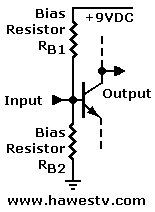Now, Let's Get Started...Pick your germanium amplifier circuit from the types below. Then follow the instructions for converting your circuit. The changes affect the base-bias resistors. (See the drawing, right.) Round calculated resistor values to the nearest standard values. Since these are bias resistors, try to come within five percent. Single-ended amps are in the first group. Double-ended amps are in the second. The examples below use NPN transistors. To convert PNP circuits, follow the examples, but reverse plus and minus power connections. Also reverse all polar parts (for example, diodes and electrolytics). |

Schematic showing base-bias resistors |
|
|
|
Words to the wise: Document your changes so that you can reverse them if necessary. Required skills: Desoldering, soldering and interpreting resistor values. Reading circuit voltages with a voltmeter. If you don't have these skills, please find a helper who does!
|
▲ WARNING. The instructions below are general guidelines. Not every circuit conforms to these guidelines. Some circuits require special modifications that are beyond this page. Also, getting a circuit operating and getting it operating well aren't always the same. This page makes no claims about perfect operation after the conversion. You might still need to tweak the circuit. This page helps you to get the bias right. The gain, frequency response, noise level, sensitivity, etc. are your responsibility. Yet many times, a converted circuit will perform just fine. Notions of satisfactory operation are matters for your personal judgement. Example part values are only for reference. See other warnings and notices at the bottom of this page. |
Go to Page: 1 2 3 4 5 6 7 Next
- Conversion Introduction
- Conversion Problems
- Conversion Process
- Conversion Examples
- Necessary Circuit Changes
- Advantages or Problems?
- Transistors & Hobby Electronics
- Parts Grades
- Project Vendor Links
- Convert Your Amplifier from Germanium to Silicon
- Replacement Transistors, Capacitors & Diodes